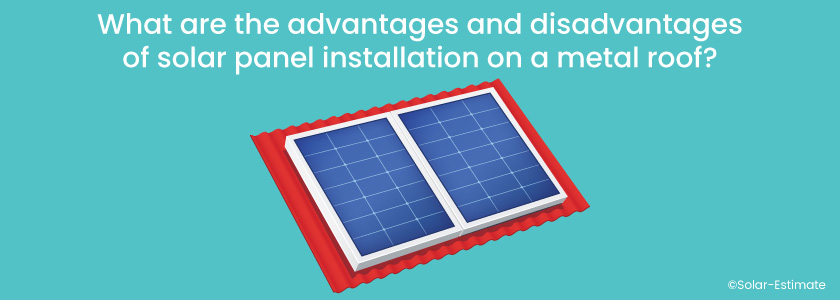What are the advantages and disadvantages of solar panel installation on a metal roof?
Written by Zeeshan Hyder
Updated August 12, 2021
8 minutes read
Categories: Monocrystalline solar panels, Net metering, Polycrystalline solar panels, Solar 101, Solar panels

When you decide to commence with installing solar, your roof type is very important to installers. Different materials have different strengths and weaknesses and may affect the installation process. Generally speaking, metal is the best choice for rooftop solar installations because of its high strength and durability. Materials such as terracotta may present problems because it is weak and brittle.
Will contractors have to drill into my roof to install solar?
If you are fortunate enough to have a standing seam metal roof a professional installer should always be able to clamp the racking for your panels to the seams of the roof without drilling.
Is my roof vulnerable to leaks from a solar panel installation?
It is extremely unlikely to experience leaks or any other sort of problem with your roof after a solar installation. Most solar companies offer workmanship and roof warranties for reassurance.
Most solar panels are designed to last over 25-30 years so having a roof that lasts longer than this is important. Modifying your roof after installing solar panels is very expensive since the panels need to be taken off and put back on again.
If for any reason your panels must be removed after installation having a standing-seam metal roof can make the job a lot simpler since it shouldn't have to be bolted into the roof.
Which roof type is best for installing solar?
All roof types are eligible for solar however, some roofs may cause additional labor costs due to an increase in difficulty of the installation. The following roofs are ranked from easiest to hardest in terms of ease of installation.
- Standing-seam metal roof
- Asphalt composite shingles
- Wood shake roofs
- Clay/stone tiled roofs
Contractors when working with standing-seam metal roofs will normally install clamps on the roof seams in order to hold up the racking for the panels.
Installing on asphalt composite is usually fine as long as the installer can find the rafters.
Wood shake roofs are relatively easy to install solar on but require flashing that must be drilled deep into the roof.
Installing solar on clay/stone tiles is by far the most difficult as they must be removed to install the mounts and the flashing and tiles must be cut so they don't contact the mounting gear.
Will my roof type affect the output of my solar panels?
Under no circumstance should the type of roof affect the output of your panels. A downside to metal roofing is that it isn't very energy efficient, meaning your utility bills may be higher due to more energy being used to heat and cool your home. The increase in energy consumption may mean your solar system sends less energy to the grid to be credited by net metering.
What is net metering and how does it work?
When your solar system produces more energy than needed in your home the excess power is sold to your utility through the grid, net metering requires your power company to value each kWh of power sent to them at the retail rate you pay for electricity. Each kWh of energy sent to the grid offsets the cost of another kWh drawn from the grid.
How does the federal tax credit work?
If you install solar anywhere within the United States in 2020, 26% of the cost of your solar system can be claimed as a deduction to your federal tax liability. To claim the tax credit simply fill out form 5695 when you do your taxes for the year.
